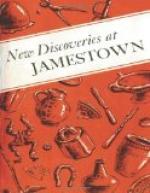[Illustration: A 17th-century lime kiln excavated at Jamestown. In it oyster shells from the James river were burned for making lime. The iron hoops which supported the arched top of the kiln buckled from the intense heat.]
[Illustration: Making lime from oyster shells in A kiln, about 1625. (Conjectural sketch by Sidney E. King.)]
OTHER CRAFTSMEN
Contemporary records, confirmed by certain objects found at Jamestown (especially small tools), reveal that pewterers, silversmiths colliers, wheelwrights, calkers, bricklayers, millwrights, shoemakers, masons, cordage makers, tanners, tobacco pipemakers, armorers, gunmakers, braziers, and others worked in the capital city at various periods between 1607 and 1699.
[Illustration: A Silversmith weighing clipped coins. (Conjectural sketch by Sidney E. King.)]
[Illustration: Brass weights and A piece of scrap brass unearthed at Jamestown. Records indicate that many METALWORKERS emigrated to Virginia during the 17th century.]
Home Industries
During archeological explorations many artifacts relating to household and town industries were recovered. It is believed that many of these small industries were home activities carried on in the houses at Jamestown. A few of these activities, and the products of them are mentioned briefly.
SPINNING AND WEAVING
A few metal parts from spinning wheels and looms have been excavated—reminders that the pioneer housewife who spun the thread and yarn, and wove the cloth for her large family, was seldom idle.
MALTING AND BREWING
One Jamestown building or house (whose brick foundations were discovered in 1955) appears to have been used for malting and brewing beer and ale, or carrying out some activity requiring distillation. A few pieces of lead were found which may have been part of a lead cistern for holding barley. The three brick ovens that were uncovered may have been used as drying kilns. A handle from a copper kettle was found near one of the ovens, and pieces of copper and lead pipes were unearthed not far from the building. The structure itself appears to have been used between 1625 and 1660.
[Illustration: Spinning thread or yarn and Weaving cloth were endless chores for the women living in the small wilderness settlement. (Conjectural sketch by Sidney E. King.)]




